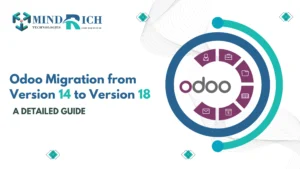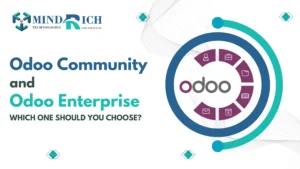In today’s market running a business isn’t just about selling products or services, instead it’s about keeping everything under control like inventory, accounts, HR, customer follow-ups and more. And especially when your team is rapidly growing, things can be quickly felt out of hand. That’s where software like Odoo ERP Software comes into the picture and Odoo Implementation became necessary.
In 2025, more and more businesses, especially small to mid-sized ones are rapidly switching to Odoo because it helps them to manage everything from just one place. No more shuffling between Excel, Tally, WhatsApp and other different apps for every department work.
What actually makes Odoo Software stand out is that it’s not just a software, instead it’s a complete set of tools and modules that can be easily customized to fit into your business. Whether you’re in manufacturing, retail, healthcare, trading etc., Odoo adapts to you, not the other way around.
This guide breaks down the entire Odoo implementation process in a simple and practical way, so that you can actually understand and apply it effectively.
What Is Odoo Software & Why It Stands Out Among ERP Systems
Odoo is an Open-Source ERP platform. Which means it provides all the core tools a business actually needs like sales, inventory, CRM, HR, accounting, purchases and more in just one place. The best part? You can only use the apps you actually need.
It’s more modular, easy to use and flexible. So, instead of managing five different systems manually, Odoo puts everything under one clean platform.
Let’s say you run a retail business. Your sales team can track customer orders, the warehouse staff can manage the stock and the accounting team can generate invoices all on the same system. Everyone works with real-time, accurate data which means no confusion and no delays.
Unlike many traditional ERP platforms that are highly expensive, rigid and take months to set up, Odoo gives you the full freedom to start small and grow at your pace.
Also Read: What is Odoo Software? The Ultimate Guide to Odoo ERP
Key Features of Odoo That Small & Mid-Size Businesses Love

Here’s what makes Odoo a favourite tool for growing businesses:
- Modular System – Choose only the apps you need. Use more later as you grow.
- Custom Workflows – Modify it to how your business actually works.
- Mobile Access – Stay updated from anywhere.
- Smart POS System – Perfect for retail businesses that need live billing and stock updates.
- Project Management – Track tasks, deadlines and costs in one place.
- Simple Dashboard – Even non-tech users can navigate it easily.
Example:
Imagine a medicine shop using the POS app – as soon as a medicine is sold, the inventory updates, billing is done instantly and the backend team knows what stock needs to reorder now.
That’s real-time clarity without any extra effort.
Why Should You Go for Odoo Implementation?
If your business is still running on spreadsheets, scattered WhatsApp messages and handwritten bills then you’re just wasting time and inviting mistakes. Odoo Implementation can be a game changer for your business.
Here’s what Odoo can do for you:
- Connects all departments
- Reduces manual mistakes
- Helps your team to collaborate better
- Gives real-time and accurate reports
- Saves admin time
- Helps you scale without adding more chaos
Odoo implementation doesn’t just automate; it simplifies everything. And simplicity is the real luxury in the business today.
Odoo Implementation: A Step-by-Step Practical Guide
No technical terms; just a real and practical plan that works in everyday business. Here is a step by step guide for successful Odoo Implementation:
1. Identify Your Needs
Before jumping in, firstly sit with your team and list down the exact areas where you’re facing issues. Are sales orders being missed? Inventory always mismatched? Know your pain points better, that’s where your Odoo journey begins.
2. Select the Right Modules
Odoo offers many modules, but you don’t need them all. Start with what matters now, maybe CRM, Inventory, Sales or Accounting. You can always scale them later as your business grows.
3. Clean Your Data
Old files usually have errors like duplicate entries, wrong numbers, incomplete customer details. Fix all these before importing into Odoo. A clean start avoids future mess.
4. Configure & Customize
Don’t get lost into too many customizations. Just make the system match your workflow, things like approval chains, invoice format, product categories. Stick to what’s actually needed.
5. Test with a Small Group
Give early access to a few team members from different departments. Let them use it first in real situations for 5–7 days. Note what works, what confuses them and what needs fixing.
6. Train Your Team
Training doesn’t mean one big session here. Break it down. Show them only what they’ll actually use. Record small videos or give them quick cheat sheets — that works much better than slides.
7. Go Live (Soft Launch)
Start using Odoo officially but be ready for questions and issues. Keep your IT/Implementation team available in the first 1–2 weeks to fix bugs or errors and support your staff.
8. Monitor Usage
Check if your team is actually using Odoo properly. Are sales people logging leads? Are invoices generated inside the system? Regular usage checks always ensure the adoption is on track.
9. Keep Improving
Even after launch, keep listening. Are reports useful? Is anything slowing down your work? Every month, refine small things to make the system more useful and comfortable for the team.
Common Challenges During Odoo Implementation & How to Avoid Them
Here are some usual mistakes and how to stay clear of them:
- Doing Too Much at Once:
One of the biggest mistakes is trying to implement everything at the same time. Don’t do that. Always start small. One department, one process at a time. This will avoid mistakes and ensure better adoption.
- Skipping Training:
If your team doesn’t understand the system, they won’t use it. Just handing over the software is not enough. So, keep training them in more simple and practical ways. Because the more confident your team feels using Odoo, the smoother things will run for the long term.
- No Testing Phase:
Testing helps you to avoid last-minute surprises. Always do a dry run. This will help you to catch errors, unexpected bugs or any process gaps before going live. Testing actually gives you clarity and confidence about your business.
- Over-Customizing:
Use Odoo’s already default setup as much as possible at least in the beginning. Too much customization leads to more confusion. So, keep it simple and scale features only when they’re absolutely necessary.
- Choosing the Wrong Partner:
Work only with someone who understands both Odoo and your industry. Ask them for relevant examples and case studies. A good implementation partner will guide you and play a key role in helping your business grow.
Real-Life Use Case: From Manual Chaos to Digital Control
A small electronics supplier was managing everything through Google Sheets, phone calls and handwritten notes. Orders were often missed. Stock mismatches were common. Customers often got late deliveries.
After Odoo implementation:
- Sales were logged instantly
- Inventory synced live
- Delivery tracking time became right
- Billing and follow-ups became accurate and automatic
His team saved hours every week and finally felt in control and due to this he found the growth in revenue by 30% in just 1st month.
Wrapping Up
Odoo Software isn’t just a magic tool or another business app. It’s a well thought-out system that brings your entire business operations under one roof, so your work becomes less about error and more about making actual progress.
Whether you’re handling daily sales, managing inventory, taking customer follow-ups or struggling with billings Odoo gives you a simple and easy way to manage it all. And the best part is that you don’t need to change your business for Odoo. It’s way flexible enough to adapt itself to how you already work just in a more better and efficient way.
More than anything, Odoo frees up your time. It removes unnecessary manual work, repetitive tasks and messy coordination across teams. Because when your internal operations run smoothly, your focus automatically shifts back to where it should be growing your business.
So if you’ve been managing everything manually or switching between too many apps, maybe it’s time for you to bring it all together under one platform. With the right guidance and step-by-step planning, Odoo Software can become the backbone for your business.
Because in today’s business world, staying organized is no longer than a luxury it’s become a necessity. And Odoo Software gives you exactly that.











